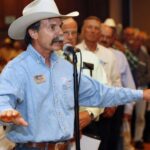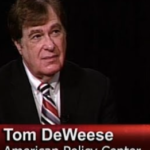USDA Signals NAIS is Dead
 |
| Max Thornsberry |
After a long-fought six-year battle, independent cattle producers have finally succeeded in stopping the National Animal Identification System (NAIS), which was an onerous plan conceived by the World Trade Organization (WTO) and promoted by the U.S. Department of Agriculture (USDA), domestic and multinational ear tag companies, as well as multinational meat packers and their closely aligned trade associations.
The battle was extremely lopsided. USDA had millions of dollars of taxpayer money — over $140 million to be precise — to develop and promote NAIS and to persuade state departments of agriculture and cattle industry trade associations to recruit as many independent cattle producers as possible into the ill-fated NAIS program. According to the Web site www.usaspending.gov, the National Cattlemen’s Foundation, part of the National Cattlemen’s Beef Association (NCBA), received over $2.1 million from the federal government in 2008 to promote NAIS.
Armed with millions of dollars and six years worth of joint government and processing-industry planning, how did NAIS get stopped?
The answer is that NAIS was stopped by the persistent, relentless pressure applied by a handful of non-conventional organizations that exclusively represented the interests of cattle farmers and ranchers, not the interests of the industrialized sectors of the U.S. beef supply chain. This was a David versus Goliath battle in which David won and the interests of independent cattle producers came out on top.
These recent victories by independent cattle producers, with far less political clout and economic power than their conventional beef industry trade association counterparts, strongly suggests that there remains a genuine reason for hope that independent cattle producers can reverse the present course of their industry — a course that is fast leading toward more and more corporate control over the U.S. cattle industry by beef packers that are capturing control over the live cattle supply chain, just as they have already captured control over both the poultry and hog supply chains.
The beef packers are now focusing their efforts on the feeding sector of the cattle industry by purchasing more and more feedlots (JBS recently purchased the nation’s largest feedlot company, Five Rivers Ranch Cattle Feeding, L.L.C.) and gaining increased control over the fed cattle market through the use of new cattle procurement tools, such as certain marketing agreements and formula-type contracts that effectively reduce the competitiveness of the fed cattle cash market.
As with every major policy issue victory, the real work begins now.
Now that NAIS has been scrapped, a new program needs to be developed to achieve improvements in the United States’ ability to quickly contain and control animal diseases. Independent cattle producers must remain directly involved in the development of this new program to ensure that it does not infringe upon their rights and privileges as did NAIS.
It is encouraging that when Agriculture Secretary Vilsack announced he was going to pursue a new approach to animal disease traceability, he also announced that the U.S. must strengthen its import controls to prevent the introduction of animal diseases at our borders. This is a high priority for independent cattle producers who intrinsically understand that we cannot continue importing diseases like BSE, bovine tuberculosis and brucellosis if we desire to maintain our industry’s reputation of producing the healthiest cattle in the world — a reputation that is the U.S. cattle industry’s competitive advantage in both the domestic market and the global market.
I encourage every cattle producer to take a new look at the relatively new organizations that have amassed uncanny successes for independent cattle producers despite seemingly impossible odds. Each of the organizations that brought us to where we’re at today is not likely to lead us in a new direction. But some of these new organizations will and they need your support to continue winning their fight to restore for the U.S. cattle industry the opportunity for U.S. cattle producers to maintain independent and profitable cattle-producing businesses all across the United States.
The future of the U.S. cattle industry is in your hands and will be determined by which organization you choose to support.
The NAIS that USDA was attempting to force down the throats of independent U.S. cattle producers, utilizing our own tax dollars, would have completely changed the way cattle farmers and ranchers do business.
While obtaining a premises ID number — the first step to a nationwide NAIS — required no effort, the second and third steps in the onerous WTO-mandated system would have been costly, difficult, and, I believe, would have generated rebellion on the range. Reporting the movement of every animal, once it left its birth farm of origin, was a completely unworkable system for producers, especially those operating in our most populous cow states, where the average cowherd size is 30 to 40 mother cows.
Imagine having to get your cattle in a chute, read the tags electronically, and report the numbers to USDA every time you moved a set of calves to another pasture, your Dad’s place, or sent a group of calves to the sale barn. Not only were you going to be required to read the tags electronically, but you were going to be required to report the tag numbers to the appropriate authorities within 48 hours of that movement, or you would be out of compliance and subject to enforcement fines: A range rebellion in the making, and completely unnecessary for a first world country like the United States.
At least for the time-being, the government has listened to the people. A spike has been driven into the heart of a one-world government’s dictatorial rule.
Maybe our Constitution is not dead?



